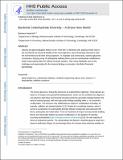| dc.contributor.author | Imperiali, Barbara | |
| dc.date.accessioned | 2021-10-27T20:09:23Z | |
| dc.date.available | 2021-10-27T20:09:23Z | |
| dc.date.issued | 2019 | |
| dc.identifier.uri | https://hdl.handle.net/1721.1/134830 | |
| dc.description.abstract | © 2019 Elsevier Ltd Glycans and glycoconjugates feature on the ‘front line’ of bacterial cells, playing critical roles in the mechanical and chemical stability of the microorganisms, and orchestrating interactions with the environment and all other living organisms. To negotiate such central tasks, bacterial glycomes incorporate a dizzying array of carbohydrate building blocks and non-carbohydrate modifications, which create opportunities for infinite structural variation. This review highlights some of the challenges and opportunities for the chemical biology community in the field of bacterial glycobiology. | |
| dc.language.iso | en | |
| dc.publisher | Elsevier BV | |
| dc.relation.isversionof | 10.1016/J.CBPA.2019.04.026 | |
| dc.rights | Creative Commons Attribution-NonCommercial-NoDerivs License | |
| dc.rights.uri | http://creativecommons.org/licenses/by-nc-nd/4.0/ | |
| dc.source | PMC | |
| dc.title | Bacterial carbohydrate diversity — a Brave New World | |
| dc.type | Article | |
| dc.contributor.department | Massachusetts Institute of Technology. Department of Biology | |
| dc.contributor.department | Massachusetts Institute of Technology. Department of Chemistry | |
| dc.relation.journal | Current Opinion in Chemical Biology | |
| dc.eprint.version | Author's final manuscript | |
| dc.type.uri | http://purl.org/eprint/type/JournalArticle | |
| eprint.status | http://purl.org/eprint/status/PeerReviewed | |
| dc.date.updated | 2021-07-16T17:43:18Z | |
| dspace.orderedauthors | Imperiali, B | |
| dspace.date.submission | 2021-07-16T17:43:19Z | |
| mit.journal.volume | 53 | |
| mit.license | PUBLISHER_CC | |
| mit.metadata.status | Authority Work and Publication Information Needed | |
